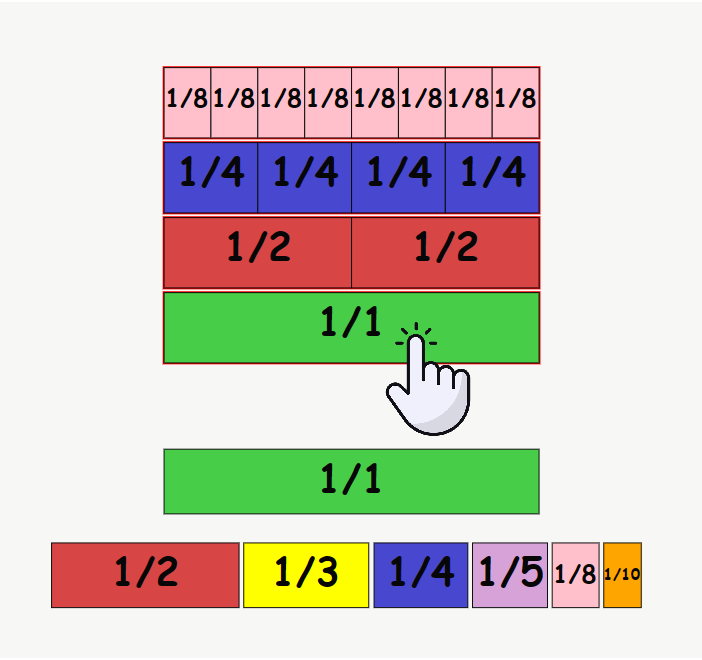Starting with the Basics: Fraction Definitions
A solid understanding of fractions begins with knowing the basic concepts and terms. Before students can confidently solve problems, they need to grasp what fractions represent and how operations like addition, subtraction, multiplication, and division work. This foundational step sets the stage for everything that follows.
🍫 Understanding What a Fraction Basically is
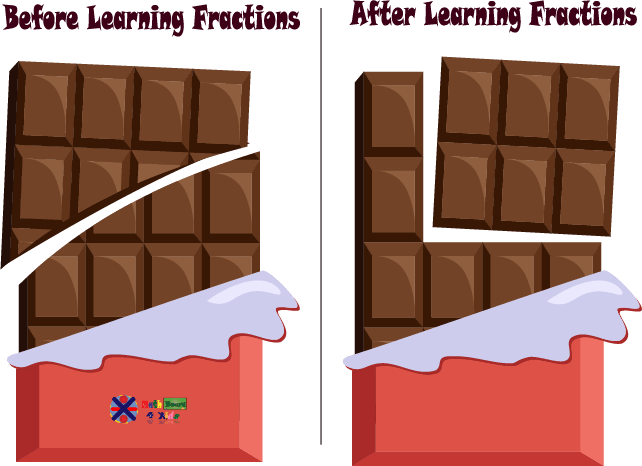
A fraction is basically just a part of something bigger — a portion taken from a whole, using that whole as the reference. To make the concept easier, we often use examples like a chocolate bar: if you take a few pieces, you're taking a fraction of the entire chocolate bar. And when you apply what you’ve learned about fractions, you can actually measure each piece and divide it equally among others — making sure everyone gets a fair share.
Numerator vs. Denominator - What's the Difference?
When students start learning about fractions, the idea of seeing two numbers stacked — one on top of the other — can feel confusing at first. They're used to working with whole numbers, so fractions look unfamiliar and even intimidating. That’s why it’s important to start with the basics: seeing how fractions are formed and why they're written this way. Once they understand that this format simply shows parts of a whole, things begin to click. And with the help of visual tools and interactive games, understanding this concept becomes much easier.
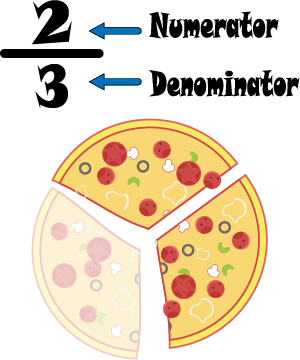
Not All Fractions Look the Same
Fractions don’t all look the same, and that’s part of what makes them so interesting. Once we understand how numerators and denominators work, we can move on to the next step: learning about the different types of fractions. This part can feel a bit overwhelming at first. Students not only have to learn how to write and read fractions, but also understand why not all fractions represent the same kind of quantity. But with clear examples and a little practice, it all starts to make sense.
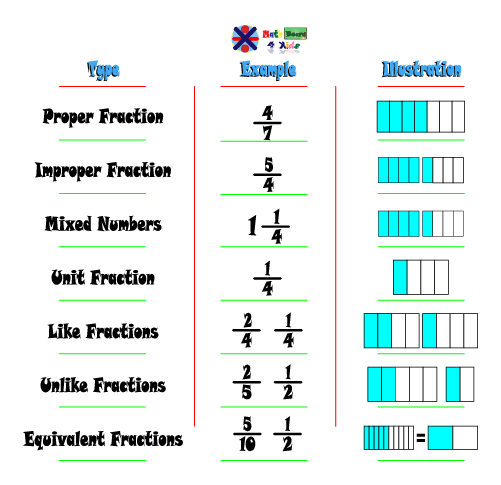
Why Fractions Matter in Our Lives?
We’ve now explored the basics — what fractions are, what their parts mean, and the different types you’ll come across. So why does all this matter? At first, it might seem like just more math to memorize, but learning about fractions can actually make a big difference. Once we see how they connect to real-life situations, math starts to feel less frustrating and a lot more useful.
Fractions in Real Life
Fractions are part of our daily lives — we just don’t always notice them. In fact, we use them all the time without even thinking about it. Whenever we share something equally, take a portion of something bigger, or measure distance or quantity, we’re using fractions. You encounter fractions when you share a pizza, drink half a bottle of water, or drive part of a longer route. Fractions are there, quietly helping us make sense of the world, every time something needs to be divided or measured.
Why Are Fractions So Frustrating for Many Students?
Understanding fractions is challenging for many students due to several factors. Let's name a few ones:
- Complexity of concepts
- Poor Teaching Methods
- Lack of Visual Representations
- Confidence Issues
Complexity of Concepts
When students start learning about fractions, it can feel like they’re stepping into a whole new world of numbers. Just as they’re starting to get comfortable with multiplication and division — often still working through those challenges — they’re suddenly expected to understand something much more abstract. They’re no longer just counting — they’re slicing, comparing, flipping, and wondering why 1/2 + 1/3 isn’t just 2/5. It’s a big jump, and if they’re already unsure about the basics, fractions can be really frustrating. And that confusion doesn’t stop with fractions, it often carries over into more advanced topics like algebra and physics, making those subjects even tougher to understand later on.
Poor Teaching Methods
Another reason students struggle with fractions is that they’re not always taught in a way that makes sense. Too often, the way fractions are introduced gets overlooked — like students are just expected to figure it out on their own. But the truth is, a lot of kids don’t really get these tricky concepts because they weren’t given the right tools or explanations in the first place. When teaching is more about memorizing steps than actually understanding what’s going on, students end up confused and frustrated — instead of feeling confident and capable.
Lack of Visual Representations
Fractions can get a lot more confusing when students don’t have a way to actually see what’s going on. Without pictures, number lines, or real objects to break things down, fractions feel like abstract rules that don’t make sense. And when it’s tough to visualize, it’s no wonder students get frustrated and give up before they really understand.
Confidence Issues
All these challenges — hard concepts, confusing teaching, and lack of visuals — add up to more than just frustration. They affect students’ confidence, making fractions feel like something they just can’t figure out. When students start believing they can’t do it, that mindset becomes a block that makes learning fractions — and future math topics — even harder. Helping students feel confident is just as important as teaching the fractions themselves.
Tools and Games to Learn Fractions
Fractions don’t have to stay frustrating. With the right tools, a bit of interactivity, and some real-world context, students can go from hating fractions to actually enjoying them. When learning becomes more hands-on and connected to things they understand everything starts to make a lot more sense. That’s why we’ve collected a set of tools designed to help students explore fractions in a way that’s fun, visual, and easy to follow.
Here are four effective ways to make learning fractions easier and more enjoyable:
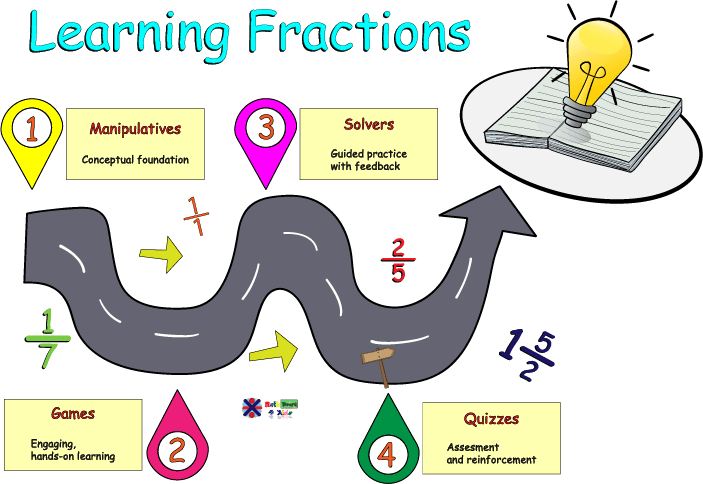
- Using Manipulatives
- Using Games
- Using Solvers
- Using Quizzes
Build Conceptual Understanding
Reinforce Skills Through Play
Catch Mistakes and Reinforce Knowledge
Assess Knowledge and Build Confidence
✋🧱 Using Manipulatives
Visuals play a big role in helping students understand fractions. When kids can actually see what a fraction looks like — whether it’s part of a circle, a bar, or something familiar like slices of cake — the concept becomes a lot easier to understand. Visuals help students compare sizes, see parts of a whole, and notice how different fractions relate to each other. For many learners, being able to see the math is what finally makes everything click
Fraction Manipulatives
🧱 Interactive Fractions
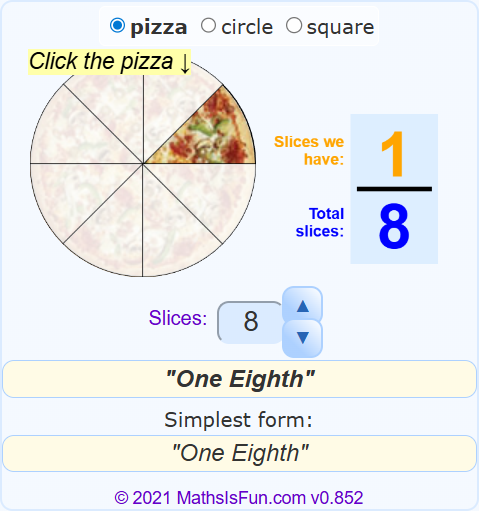
🗒️ Description
If you're just starting with fractions, this tool is a simple and fun way to get the hang of numerators and denominators.
🎯 Learning Goals
Visual Fraction Comparison
🎓 Grade
3 - 6
Site
Math is Fun🔗 Link
Interactive Fractions🧱 Fraction Strips
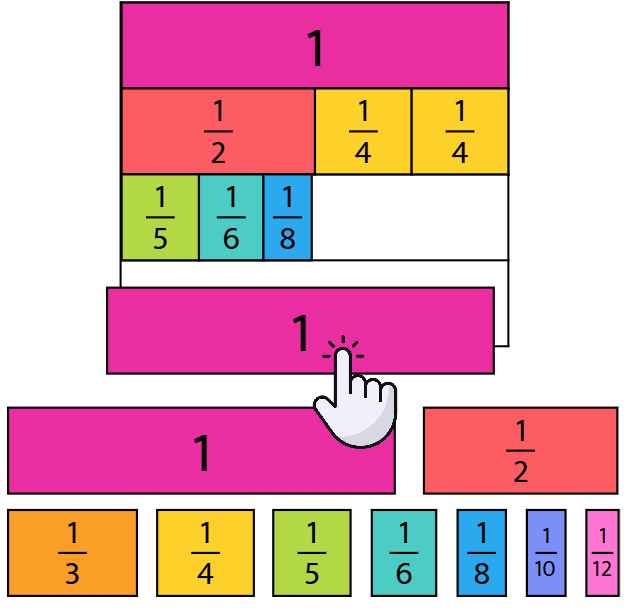
🗒️ Description
This interactive tool helps students visualize and compare fractions using fraction strips. It’s great for modeling, solving problems, and exploring equivalent fractions.
🎯 Learning Goals
Visual Fraction Comparison
🎓 Grade
3 - 6
Site
Toy Theater🔗 Link
Fraction Strips🧱 Visualizing Fractions Using Bars

🗒️ Description
Showing Fractions is a great game and tool. Students match different fraction shapes to their correct values. It’s a great way to build visual understanding of fractions and practice recognizing how parts relate to a whole.
🎯 Learning Goals
Visual Fraction Comparison
🎓 Grade
3 - 6
Website
Math Board 4 Kids🔗 Link
Showing Fractions🧱 Fractions: Intro

🗒️ Description
Understand how changes to the numerator or denominator affect a fraction’s value, and learn to represent, compare, and match fractions using numbers, visuals, and number lines.
🎯 Learning Goals
Fraction Sense
🎓 Grade
3 - 6
Website
Phet Colorado🔗 Link
Fractions: Intro🧱 Visualize Multiplication of Fractions Using Models

🗒️ Description
This game helps students see how multiplying fractions really works. By lining up two fractions in rows and columns, they can count the shaded squares to find the product. It’s a simple but powerful visual that makes fraction multiplication easier to understand.
🎯 Learning Goals
Fraction Multiplication
🎓 Grade
4 - 6
Website
Math Board 4 Kids🔗 Link
Visualize Multiplication of Fractions Using Models🧱 Adding fractions
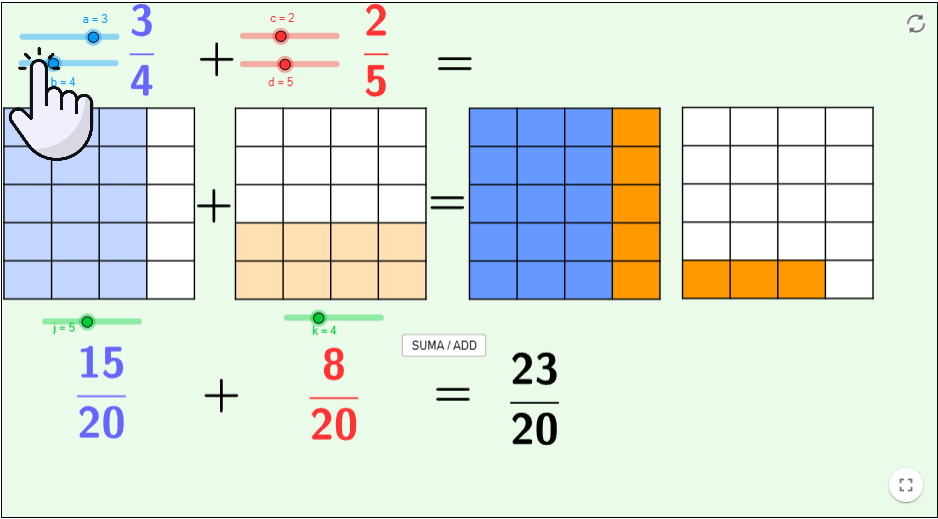
🗒️ Description
This manipulative helps students see how adding fractions really works. It’s a great visual tool that makes fraction addition easier to understand.
🎯 Learning Goals
Adding fractions
🎓 Grade
4 - 6
Website
Geogebra🔗 Link
Adding fractions🧱 Proper/Improper Fractions
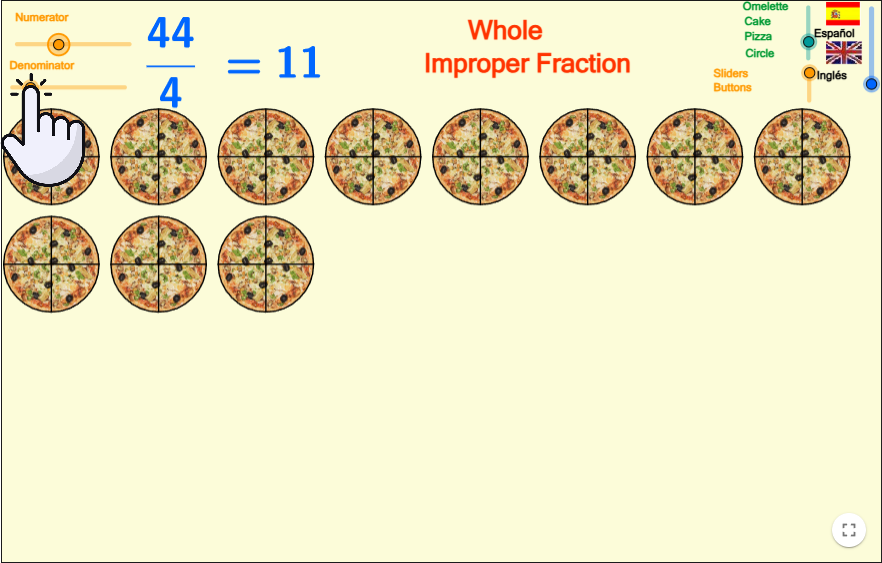
🗒️ Description
This interactive fraction tool allows users to explore and visualize different types of fractions by adjusting the numerator and denominator using sliders or buttons.
🎯 Learning Goals
Proper fractions, Unit fractions, Improper fractions, Improper fractions
🎓 Grade
4 - 6
Website
Geogebra🔗 Link
Proper/Improper Fractions🧩 Using Games
Games are a powerful way to help kids understand fractions. When students play with fractions through games, they get to explore concepts in a hands-on, interactive way that makes things easier to understand. Games turn learning into an adventure, giving kids the chance to practice, experiment, and build confidence without the pressure.
Now that we’ve seen how useful games can be, let’s take a look at two fun, interactive games designed to help students explore fractions in a way that feels more like play than practice.
🎮 Fraction Games
Ordering and Comparing Fractions
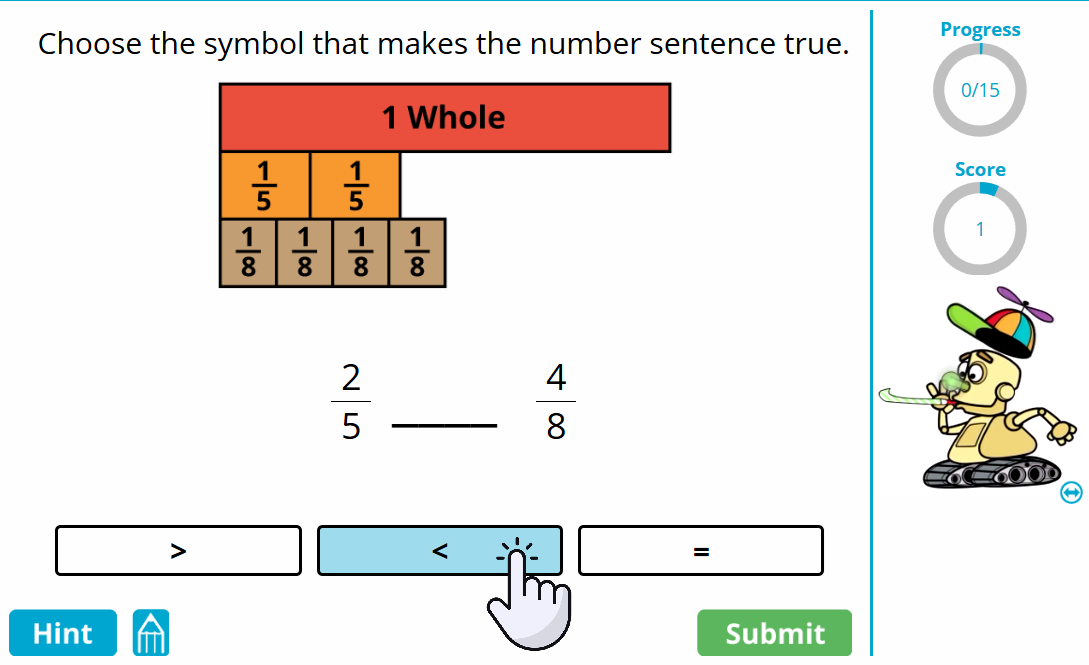
🗒️ Description
Compare two fractions and choose the correct symbol (>, <, or=) to complete the number sentence and show the correct relationship between them. Use strategies like finding common denominators or comparing fraction sizes to decide which is greater, smaller, or if they are equal
🎯 Learning Goals
Ordering and Comparing Fractions
🎓 Grade
3 - 6
Website
I Know It🔗 Link
Ordering and Comparing Fractions🎮 My Little Kitchen: Fraction Game
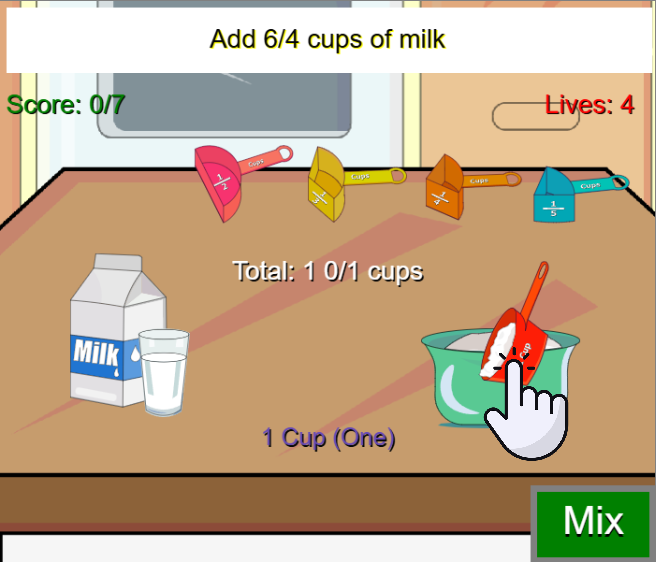
🗒️ Description
In this game, students step into the role of a baker, making cookies or cakes from scratch. They'll measure out five different ingredients using cups and tablespoons, then store a portion of the cookies in a jar. It’s a fun and practical way to connect fractions to real-life tasks like cooking and dividing quantities.
🎯 Learning Goals
All Fraction Operations
🎓 Grade
3 - 6
Website
Math Board 4 Kids🔗 Link
My Little Kitchen: Fraction Game🎮 Simplifying Fractions Game
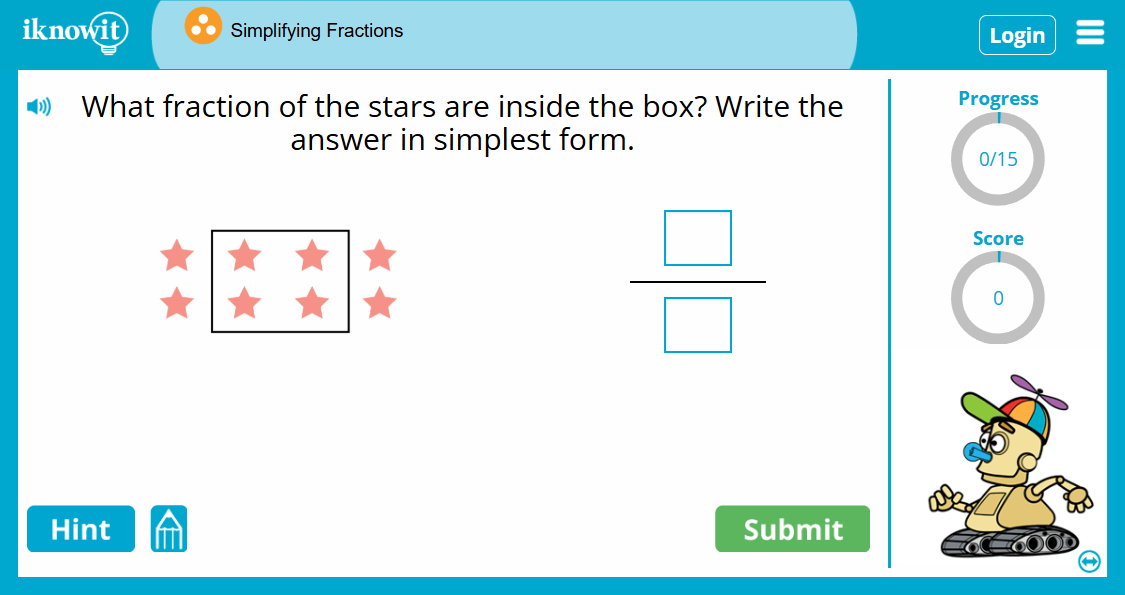
🗒️ Description
Students will learn how to reduce fractions to their simplest form by dividing both the numerator and the denominator by the same number, known as a common factor.
🎯 Learning Goals
Simplifying Fractions
🎓 Grade
3 - 6
Website
I Know It🔗 Link
Simplifying Fractions Game🎮 Fraction Matcher
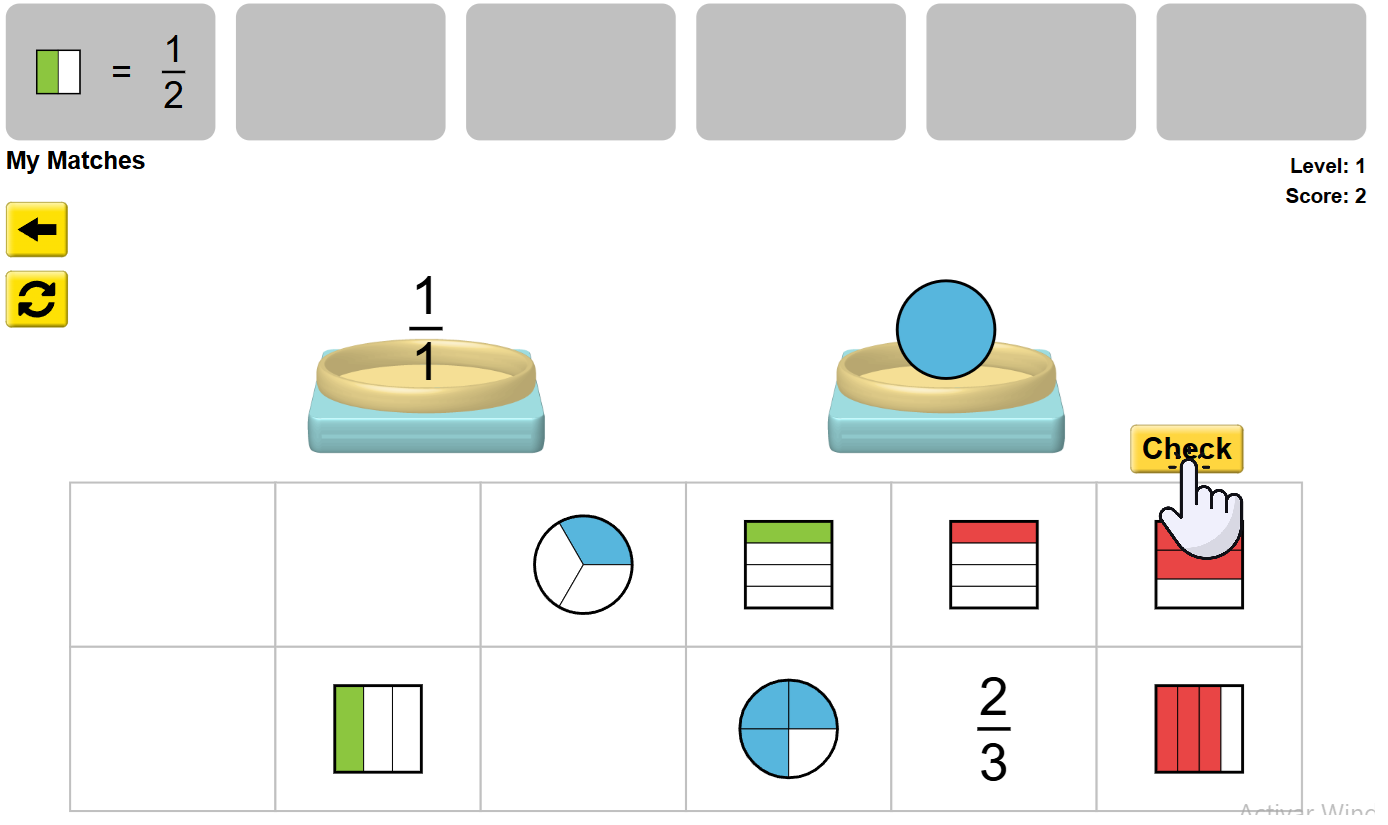
🗒️ Description
This game helps students learn to compare fractions by grouping equal ones. It offers multiple levels, allowing students to choose based on their skill and experience.
🎯 Learning Goals
Comparing Fractions (Learn Equivalent Fractions)
🎓 Grade
3 - 6
Website
Phet Colorado🔗 Link
Fraction Matcher🎮 My Bakery: Fraction Game
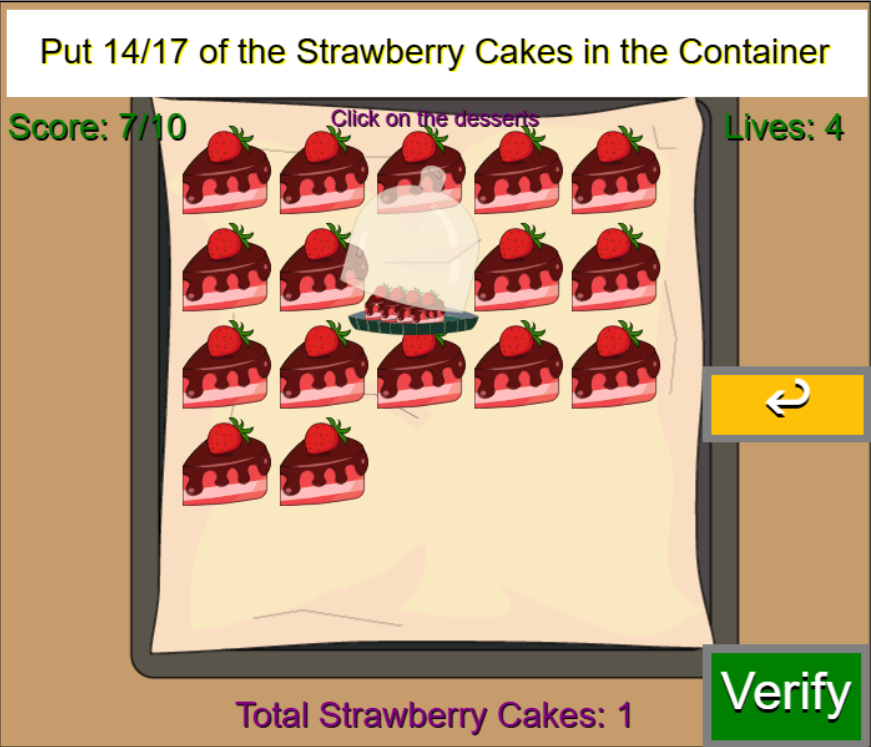
🗒️ Description
In this game students are given a specific fraction (like 12/23) and must drag the correct number of cookies into a jar. It’s a fun way to help kids connect fractions to real-world quantities.
🎯 Learning Goals
Fraction Sense
🎓 Grade
3 - 6
Website
Math Board 4 Kids🔗 Link
My Bakery: Fraction Game🧮 Using Fraction Solvers
Fraction solvers are useful because they provide immediate, targeted feedback while guiding students through the problem-solving process. This approach turns mistakes into learning opportunities, making the experience less discouraging and more productive. Practicing with solvers helps students feel more in control and confident, as they begin to recognize patterns, avoid common errors, and succeed independently.
🧑🏫 Fractions Solvers
They can use the pre-filled fractions or enter their own, then try solving the problem at their own pace. If they make a mistake, the tool highlights exactly where they went wrong, helping them learn from it. It’s a simple, effective way to practice and build confidence through feedback.
🧮 Add Fractions Practice Tool
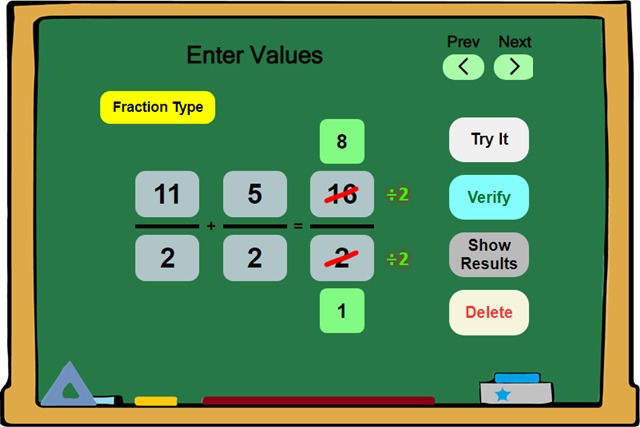
🗒️ Description
This interactive solver lets students practice adding like fractions.
🎯 Learning Goals
Adding Like Fractions
🎓 Grade
4 - 6
Website
Math Board 4 Kids🔗 Link
Add Fractions Practice Tool🧠 All Fractions Calculator
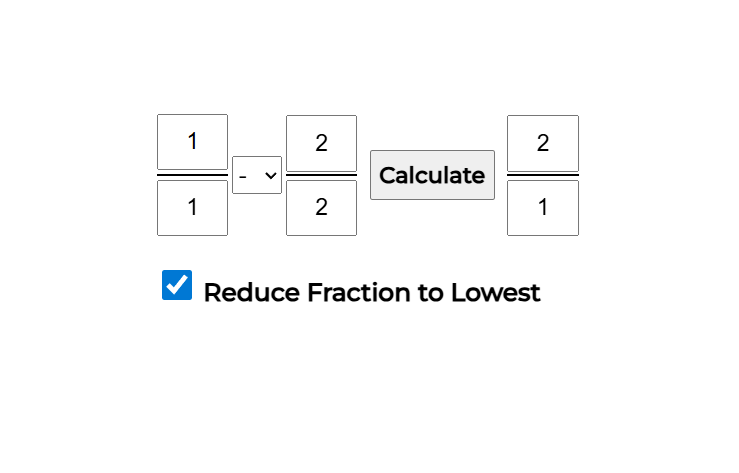
🗒️ Description
This tool is perfect for students, teachers, or anyone working with fractions. Whether you're simplifying, comparing, or just calculating, it makes the process fast and straightforward.
🎯 Learning Goals
All Fractions
🎓 Grade
4 - 6
Website
Maths For Kids🔗 Link
All Fractions Calculator🧮 Subtract Fractions Practice Tool

🗒️ Description
This solver lets students practice subtracting like fractions at their own pace.
🎯 Learning Goals
Subtracting Like Fractions
🎓 Grade
4 - 6
Website
Math Board 4 Kids🔗 Link
Subtract Fractions Practice Tool🧠 Fraction Calculator
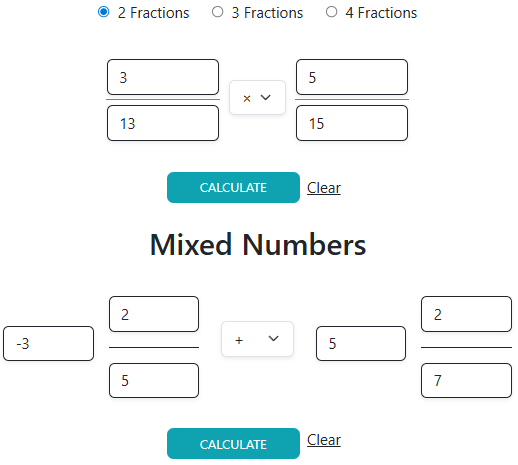
🗒️ Description
This calculator lets students practice all fractions operations.
🎯 Learning Goals
All Fractions
🎓 Grade
4 - 6
Website
Fraction Calculator🔗 Link
Fraction Calculator📝 Using Quizzes
Quizzes are a great way for students to check their understanding and see how much they’ve learned. After working through games, visual tools, and solvers, quizzes give them a chance to apply their knowledge in an open environment where mistakes are part of the process. Whether it’s a few multiple-choice questions or short problems to solve, quizzes help reinforce key ideas and build confidence through practice.
✏️📄 Fraction Quizzes
This quizzes give students a chance to apply what they’ve learned through real-life examples, like cooking, measuring, sharing, and more. It’s a great way to make fractions feel useful and familiar while reinforcing key skills in a fun, practical way.
❓ Adding Unlike Fractions Quiz
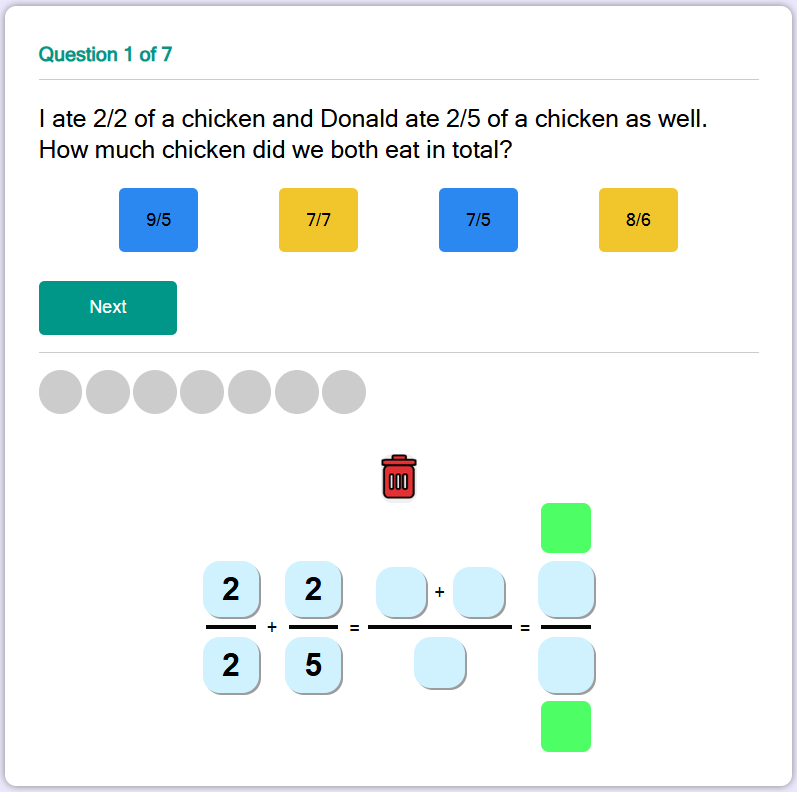
🗒️ Description
This quiz helps students practice adding fractions through real-life situations.
🎯 Learning Goals
Adding Unlike Fractions
🎓 Grade
4 - 6
Website
Math Board 4 Kids🔗 Link
Unlike Fractions Quiz📝 Fractions and Cooking Quiz
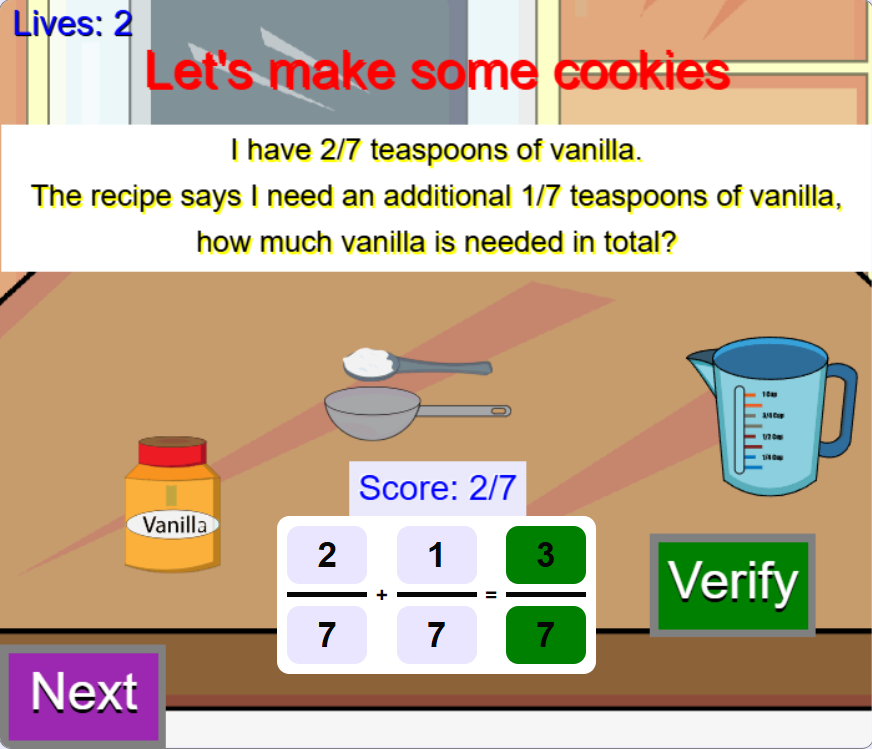
🗒️ Description
This game-quiz helps students practice all fractions operations with real-life cooking examples.
🎯 Learning Goals
All Fractions
🎓 Grade
4 - 6
Website
Math Board 4 Kids🔗 Link
Fraction and Cooking QuizSo there you have it — just a few of the many tools and games that can turn fractions from frustrating to fun. Whether you're a teacher, parent, or student, using these resources can make a real difference in building confidence and understanding. Remember, the key to mastering fractions is consistent, hands-on practice—and a little play along the way. These engaging activities make that practice more meaningful and effective!

